Interactive Effects of Gibberellic Acid and Nitrogen Fertilization on the Growth, Yield, and Quality of Sugar Beet
Abstract
1. Introduction
2. Materials and Methods
3. Results
3.1. Impacts of Nitrogen Fertilizer Levels on Sugar Beet Growth and Yield Parameters
3.2. Impacts of Foliar Applications of GA3 on Sugar Beet Growth and Yield Parameters
3.3. Impact of GA3 Spraying Times on Sugar Beet Growth and Yield Parameters
3.4. Interactive Effects of GA3 and Nitrogen Fertilization on Growth and Yield of Sugar Beet
4. Discussion
5. Conclusions
Author Contributions
Funding
Data Availability Statement
Conflicts of Interest
References
- Ministry of Agriculture and Land Reclamation. Sugar Crops and Sugar Production in Egypt and the World; MALR Annual Report; Council of Sugar Crops: Giza, Egypt, 2019.
- Artyszak, A.; Gozdowski, D. The effect of growth activators and plant growth-promoting rhizobacteria (PGPR) on the soil properties, root yield, and technological quality of sugar beet. Agronomy 2020, 10, 1262. [Google Scholar] [CrossRef]
- Khan, N.; Bano, A.; Curá, J.A. Role of Beneficial Microorganisms and Salicylic Acid in Improving Rainfed Agriculture and Future Food Safety. Microorganisms 2020, 8, 1018. [Google Scholar] [CrossRef] [PubMed]
- Gehl, R.J.; Boring, T.J. In-season prediction of sugar beet yield, quality, and nitrogen status using an active sensor. Agron. J. 2011, 103, 1012–1018. [Google Scholar] [CrossRef]
- Chatterjee, A.; Subedi, K.; Franzen, D.W.; Mickelson, H.; Cattanach, N. Nitrogen fertilizer optimization for sugar beet in the Red River Valley of North Dakota and Minnesota. Agron. J. 2018, 110, 1554–1560. [Google Scholar] [CrossRef]
- Abd El-Lateef, E.M.; Abd El-Salam, M.S.; Elewa, T.A.; Farrag, A.A. Effect of organic manure and nitrogen level on sugar beet (Beta vulgaris Var. Saccharifera L.) yield and root nitrate content. Am. Eurasian J. Agron. 2019, 12, 1–5. [Google Scholar] [CrossRef]
- Pytlarz-Kozicka, M. The effect of nitrogen fertilization and anti-fungal plant protection on sugar beet yielding. Plant Soil Environ. 2005, 51, 232–236. [Google Scholar] [CrossRef]
- Van Eerd, L.L.; Congreves, K.A.; Zandstra, J.W. Sugar beet (Beta vulgaris L.) storage quality in large outdoor piles is impacted by pile management but not by nitrogen fertilizer or cultivar. Can. J. Plant Sci. 2012, 92, 129–139. [Google Scholar] [CrossRef]
- Yin, H.; Li, B.; Wang, X.; Xi, Z. Effect of ammonium and nitrate supplies on nitrogen and sucrose metabolism of cabernet sauvignon (Vitis vinifera cv.). J. Sci. Food Agric. 2020, 100, 5239–5250. [Google Scholar] [CrossRef]
- Jaggard, K.W.; Qi, A.; Armstrong, M.J. A meta-analysis of sugar beet yield responses to nitrogen fertilizer measured in England since 1980. J. Agric. Sci. 2009, 147, 287–301. [Google Scholar] [CrossRef]
- Koch, H.; Laufer, D.; Nielsen, O.; Wilting, P. Nitrogen requirement of fodder and sugar beet (Beta vulgaris L.) cultivars under high-yielding conditions of northwestern Europe. Arch. Agron. Soil Sci. 2016, 62, 1222–1235. [Google Scholar] [CrossRef]
- Tsialtas, J.T.; Maslaris, N. Nitrogen effects on yield, quality and K/Na selectivity of sugar beets grown on clays under semi-arid, irrigated conditions. Int. J. Plant Prod. 2013, 7, 355–372. [Google Scholar] [CrossRef]
- Hosseinpour, M.; Paknezhad, A.; Naderi, A.; Eslamizadeh, R.; Abadi, V.Y.; Sharifi, V.H. Effect of N rates on growth characteristics, yield and quality of autumn-sown sugar beet. J. Sugar Beet 2013, 29, 17–26. [Google Scholar]
- Prvulovic, D.; Popović, M.; Malenčić, Đ.; Marinković, B.; Jacimovic, G. Effects of nitrogen fertilization on the biochemical and physiological parameters in leaves and root of sugar beet associated with Azotobacter chroococcum. J. Plant Nutr. 2009, 33, 15–26. [Google Scholar] [CrossRef]
- El-Sarag, E.I.; Moselhy, S.H. Response of sugar beet quantity and quality to nitrogen and potassium fertilization under sandy soils conditions. Asian J. Crop Sci. 2013, 5, 295–303. [Google Scholar] [CrossRef]
- Abdelaal, K.A.; Sahar, F.T. Response of sugar beet plant (Beta vulgaris L.) to mineral nitrogen fertilization and bio-fertilizers. Int. J. Curr. Microbiol. Appl. Sci. 2015, 4, 677–688. [Google Scholar]
- Mekdad, A.A.A. Sugar beet productivity as affected by nitrogen fertilizer and foliar spraying with boron. Int. J. Curr. Microbiol. Appl. Sci. 2015, 4, 181–196. [Google Scholar]
- Mekdad, A.A.A.; Rady, M.M. Response of Beta vulgaris L. to nitrogen and micronutrients in dry environment. Plant Soil Environ. 2016, 62, 23–29. [Google Scholar] [CrossRef]
- Leilah, A.A.; Abdel-Moneam, M.A.; Shalaby, G.A.; Abdou, M.A.E.; Abd El-Salam, H.M. Effect of plant population and distribution and nitrogen levels on yield and quality of sugar beet. J. Plant Prod. Mansoura Univ. 2017, 8, 591–597. [Google Scholar] [CrossRef]
- Tarkalson, D.D.; Bjorneberg, D.L.; Lentz, R.D. Effects of manure history and nitrogen fertilizer rate on sugar beet production in the Northwest US. Crop Forage Turfgrass Manag. 2018, 4, 1–9. [Google Scholar] [CrossRef]
- Afshar, R.K.; Nilahyane, A.; Chen, C.; He, H.; Stevens, W.B.; Iversen, W.M. Impact of conservation tillage and nitrogen on sugar beet yield and quality. Soil Tillage Res. 2019, 191, 216–223. [Google Scholar] [CrossRef]
- Zarski, J.; Tomaszewska, R.K.; Dudek, S. Impact of irrigation and fertigation on the yield and quality of sugar beet (Beta vulgaris L.) in a moderate climate. Agronomy 2020, 10, 166. [Google Scholar] [CrossRef]
- Dotto, L.; Silva, V. Beet seed priming with growth regulators. Semina Ciências Agrárias 2017, 38, 1785–1798. [Google Scholar] [CrossRef]
- Gupta, R.; Chakrabarty, S.K. Gibberellic acid in plant: Still a mystery unresolved. Plant Signal. Behav. 2013, 8, e25504. [Google Scholar] [CrossRef]
- Miceli, A.; Moncada, A.; Sabatino, L.; Vetrano, F. Effect of gibberellic acid on growth, yield, and quality of leaf lettuce and rocket grown in a floating system. Agronomy 2019, 9, 382. [Google Scholar] [CrossRef]
- El-Taweel, F.M.; Abou EL-Magd, B.M.; Aboushady, K.A. Response of some sugar beet cultivars to growth regulator treatments. J. Agric. Sci. Mansoura Univ. 2004, 23, 5501–5511. [Google Scholar]
- Abdou, M.A. Effect of nitrogen fertilizer levels and gibberellic acid treatments on sugar beet productivity and quality. Egypt. J. Appl. Sci. 2009, 24, 497–506. [Google Scholar]
- Selim, E.H.H.; Abdou, M.A.; Sarhan, H.M.; Geddawy, E.; Dalia, I.H. Effect of foliar fertilization with urea and gibberellic acid on sugar beet (Beta vulgaris L.). J. Agric. Sci. Mansoura Univ. 2009, 34, 1829–1837. [Google Scholar] [CrossRef]
- Ibrahim, M.M.; Azaz, N.A.E.; Khalifa, Y.A.M.; Khames, E.M.M. Effect of planting methods and growth regulators on yield and quality of some sugar beet cultivars. Minia J. Agric. Res. Develop. 2016, 36, 407–427. [Google Scholar]
- Gomaa, M.A.; Kandil, E.E.; Yousif, H.Y.I. Sugar beet yield and quality as affected by growth regulators, mineral and bio-fertilization in Nubaria Region. Alex. Sci. Exch. J. 2019, 40, 419–426. [Google Scholar] [CrossRef]
- Khan, N.; Bano, A. Exopolysaccharide producing rhizobacteria and their impact on growth and drought tolerance of wheat grown under rainfed conditions. PLoS ONE 2019, 14, e0222302. [Google Scholar] [CrossRef]
- Sullivan, E.F. Plant Growth Regulator Potential on Sugar beets. In Plant Growth Regulators; Stutte, C.A., Ed.; ACS Publications: Washington, WA, USA, 1977; Volume 159, pp. 68–71. [Google Scholar] [CrossRef]
- Nelson, R.T.; Wood, R.R. Studies of chemical treatments on sugar beets including gibberellic acid, 2,4-D, and maleic hydrazide. J. Am. Soc. Sugar Beet Technol. 1958, 10, 76–79. [Google Scholar] [CrossRef]
- Peterson, D.F. Effect of gibberellic acid on sucrose, purity, and weight of sugar beets. J. Am. Soc. Sugar Beet Technol. 1961, 11, 320–322. [Google Scholar] [CrossRef]
- El-Fiki, A.I.I.; Mohamed, F.G.; El-Mansoub, M.M.A. Studied on sugar beet rust disease in Egypt. (II): Management of disease under field conditions. In Proceedings of the 11th Congress of Phytopathology, Giza, Egypt, 28 November 2007; pp. 41–57. [Google Scholar]
- Carruthers, A.; Oldfield, J.F.T. Methods for the assessment of beet quality. Int. Sugar J. 1960, 63, 72–74. [Google Scholar]
- Gomez, K.N.; Gomez, A.A. Statistical Producers for Agricultural Research, 2nd ed.; John Wiley and Sons: New York, NY, USA, 1984; p. 68. [Google Scholar]
- Waller, R.A.; Duncan, D.B. A bays rule for symmetric multiple comparison problem. Am. Stat. Assoc. J. 1969, 1485–1503. [Google Scholar] [CrossRef]
- Gojon, A. Nitrogen nutrition in plants: Rapid progress and new challenges. J. Exp. Bot. 2017, 68, 2457–2462. [Google Scholar] [CrossRef] [PubMed]
- Aroiee, H.; Omidbaigi, R. Effects of nitrogen fertilizer on productivity of medicinal pumpkin. Acta Hort. 2004, 629, 415–419. [Google Scholar] [CrossRef]
- Bloom, A.J. The increasing importance of distinguishing among plant nitrogen sources. Curr. Opin. Plant Biol. 2015, 25, 10–16. [Google Scholar] [CrossRef]
- Märländer, B. Influence of nitrogen supply on yield and quality of sugar beet. J. Plant Nutr. Soil Sci. 1990, 153, 327–332. [Google Scholar] [CrossRef]
- Hassanin, M.A.; Elayan, S.E.D. Effect of phosphorus and nitrogen fertilization with respect to quality, yield and yield components of some sugar beet varieties grown in Upper Egypt. J. Agric. Sci. Mansoura Univ. 2000, 25, 7389–7398. [Google Scholar]
- Dastorani, M.A.; Armin, M. Effect of the nitrogen rate and weed control treatments on the quantitative and qualitative yield of sugar beet. Russ. Agric. Sci. 2019, 45, 423–429. [Google Scholar] [CrossRef]
- Mekdad, A.A.A.; Shaaban, A. Integrative applications of nitrogen, zinc, and boron to nutrients-deficient soil improves sugar beet productivity and technological sugar contents under semi-arid conditions. J. Plant Nutr. 2020, 43, 1–16. [Google Scholar] [CrossRef]
- Richards, D.E.; King, K.E.; Ali, A.T.; Harberd, N.P. How gibberellin regulates plant growth and development: A molecular genetic analysis of gibberellin signaling. Ann. Rev. Plant Physiol. Plant Mol. Biol. 2001, 52, 67–88. [Google Scholar] [CrossRef] [PubMed]
- Naseem, H.; Ahsan, M.; Shahid, M.A.; Khan, N. Exopolysaccharides producing rhizobacteria and their role in plant growth and drought tolerance. J. Basic Microbiol. 2018, 58, 1009–1022. [Google Scholar] [CrossRef] [PubMed]
- Qotob, M.A.; Nasef, M.A.; Elhakim, H.K.; Shaker, O.G.; Habashy, N.R.; Abdelhamid, I.A. Integrated effect of plant growth regulators with boron sources on some biological parameters of sugar beet. Plant Arch. 2020, 20, 1783–1793. [Google Scholar] [CrossRef]
- Poostchi, I.; Schmehl, W.R. Effect of gibberellic acid, several growth retardants and nitrogen levels on yield and quality of sugar beets. J. Am. Soc. Sugar Beet Technol. 1971, 16, 323–331. [Google Scholar] [CrossRef]
- Sardoei, A.S.; Shahadadi, F.; Shahdadneghad, M.; Imani, A.F. The effect of gibberellic acid on reducing sugar of jerusalem cherry (Solanum pseudocapsicum L.) Plant. Int. J. Adv. Biol. Biomed. Res. 2014, 2, 690–695. [Google Scholar]
- Rahman, M.S.; Mohammed, N.I.; Tahar, A.; Karim, M.A. Influence of GA3 and MH and their time of spray on morphology, yield contributing characters and yield of soybean. Asian J. Plant Sci. 2004, 3, 602–609. [Google Scholar] [CrossRef][Green Version]
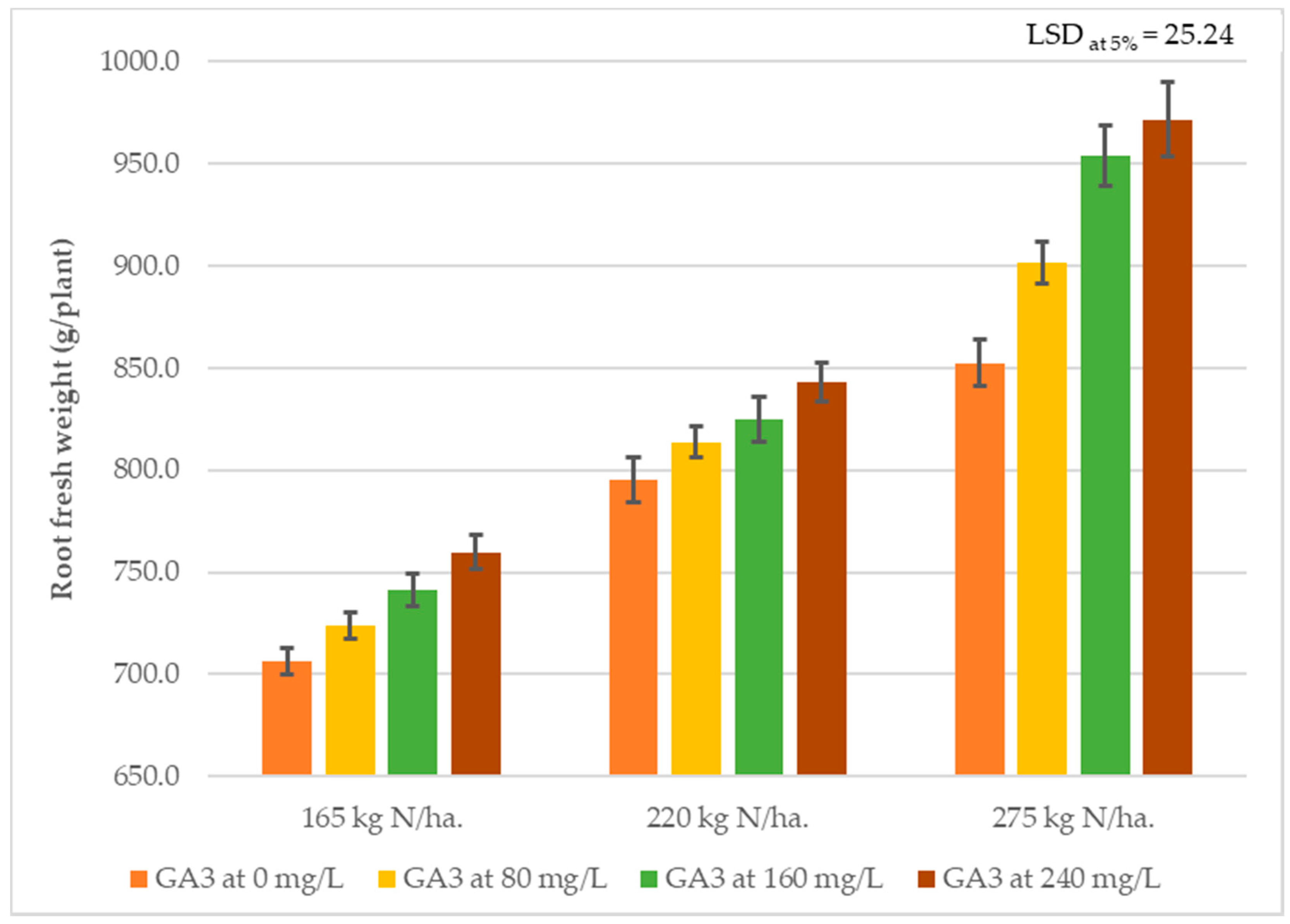

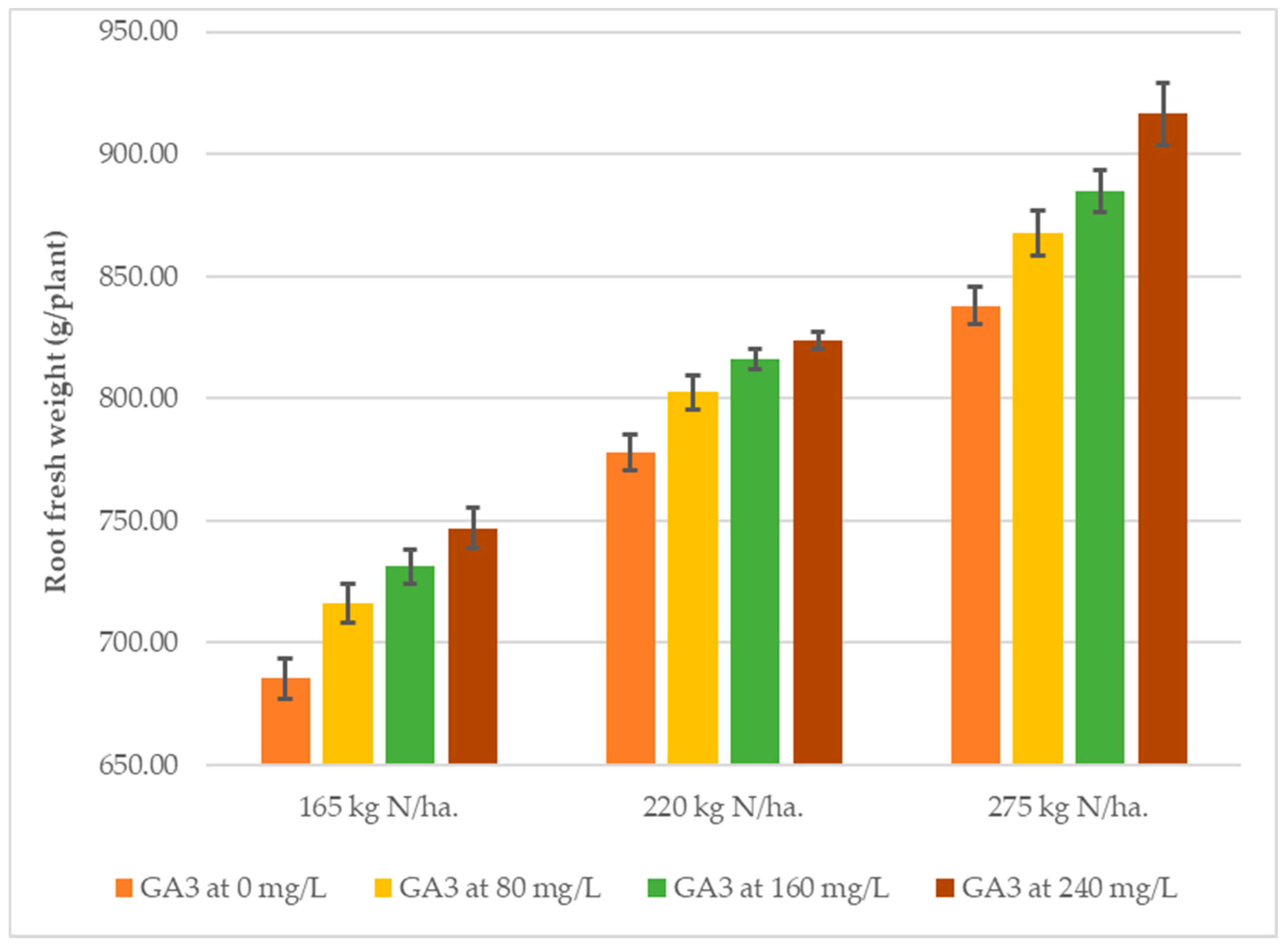
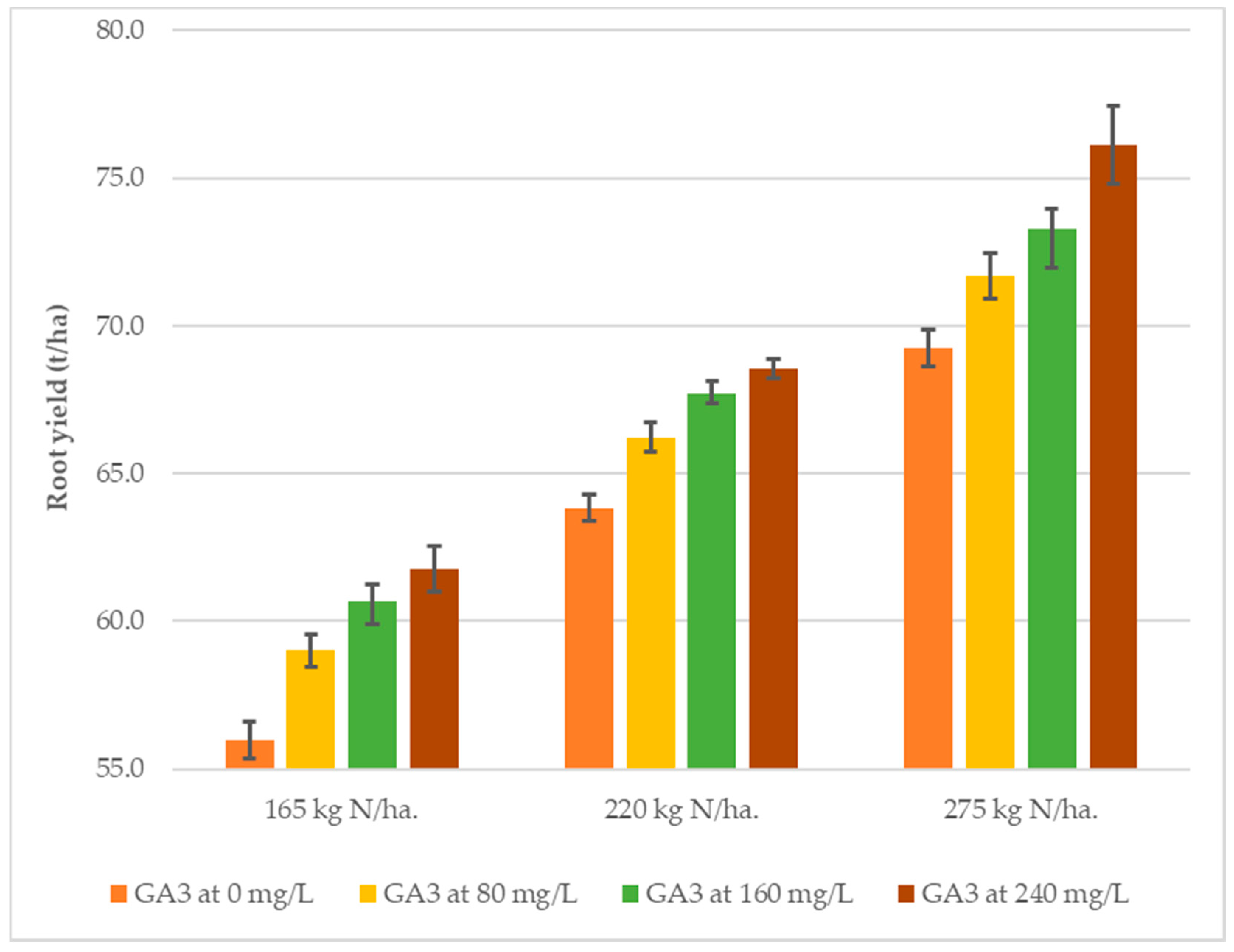
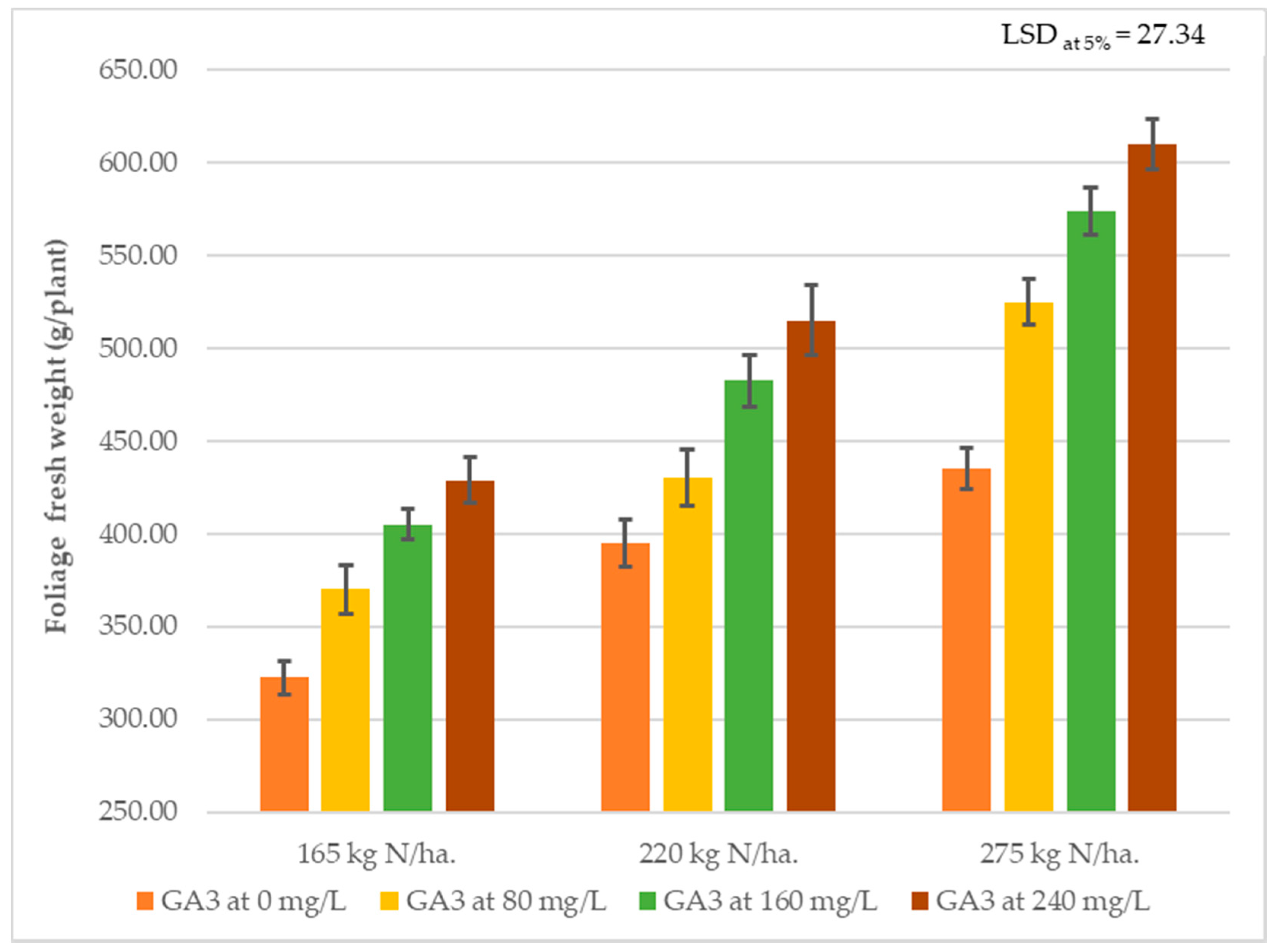
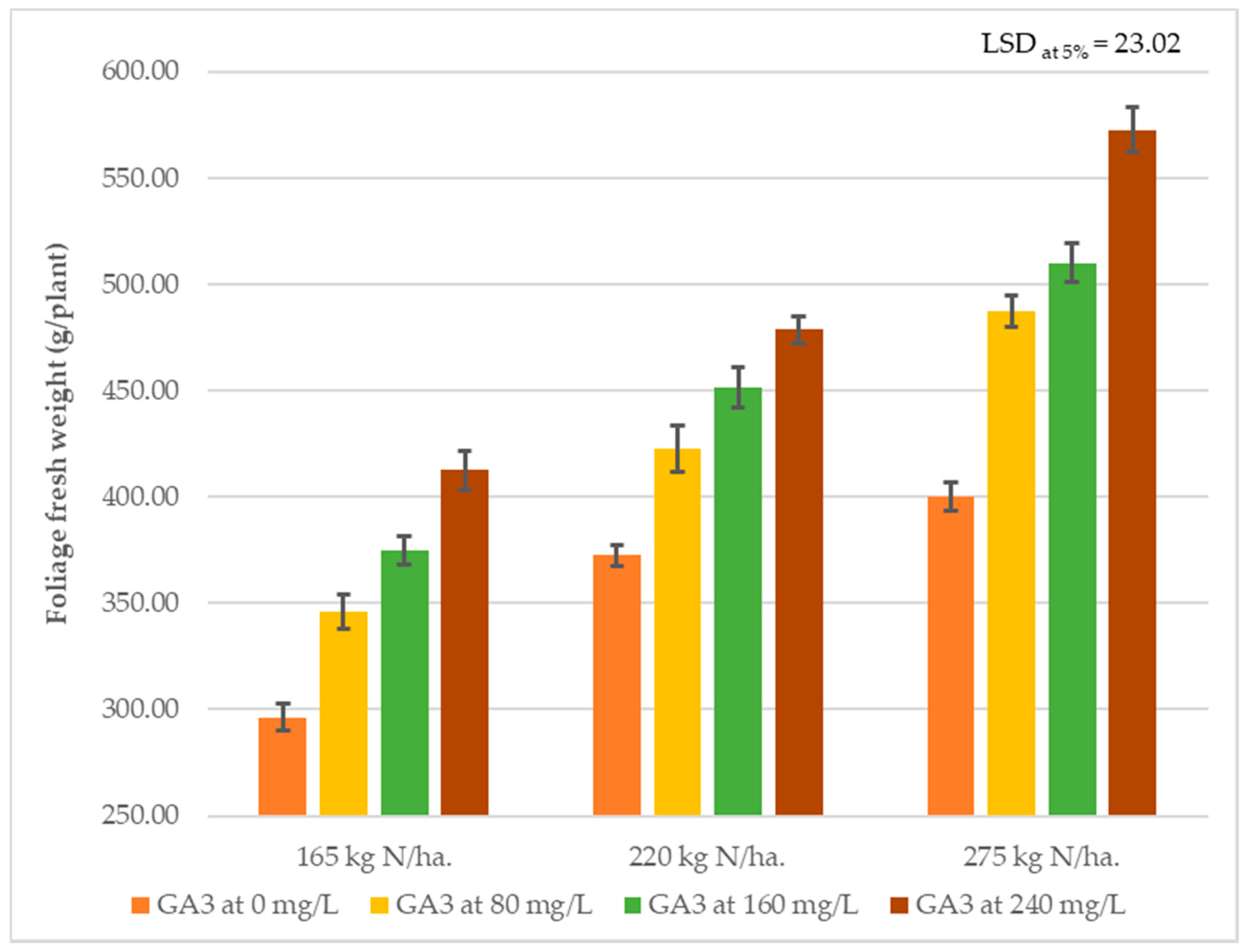
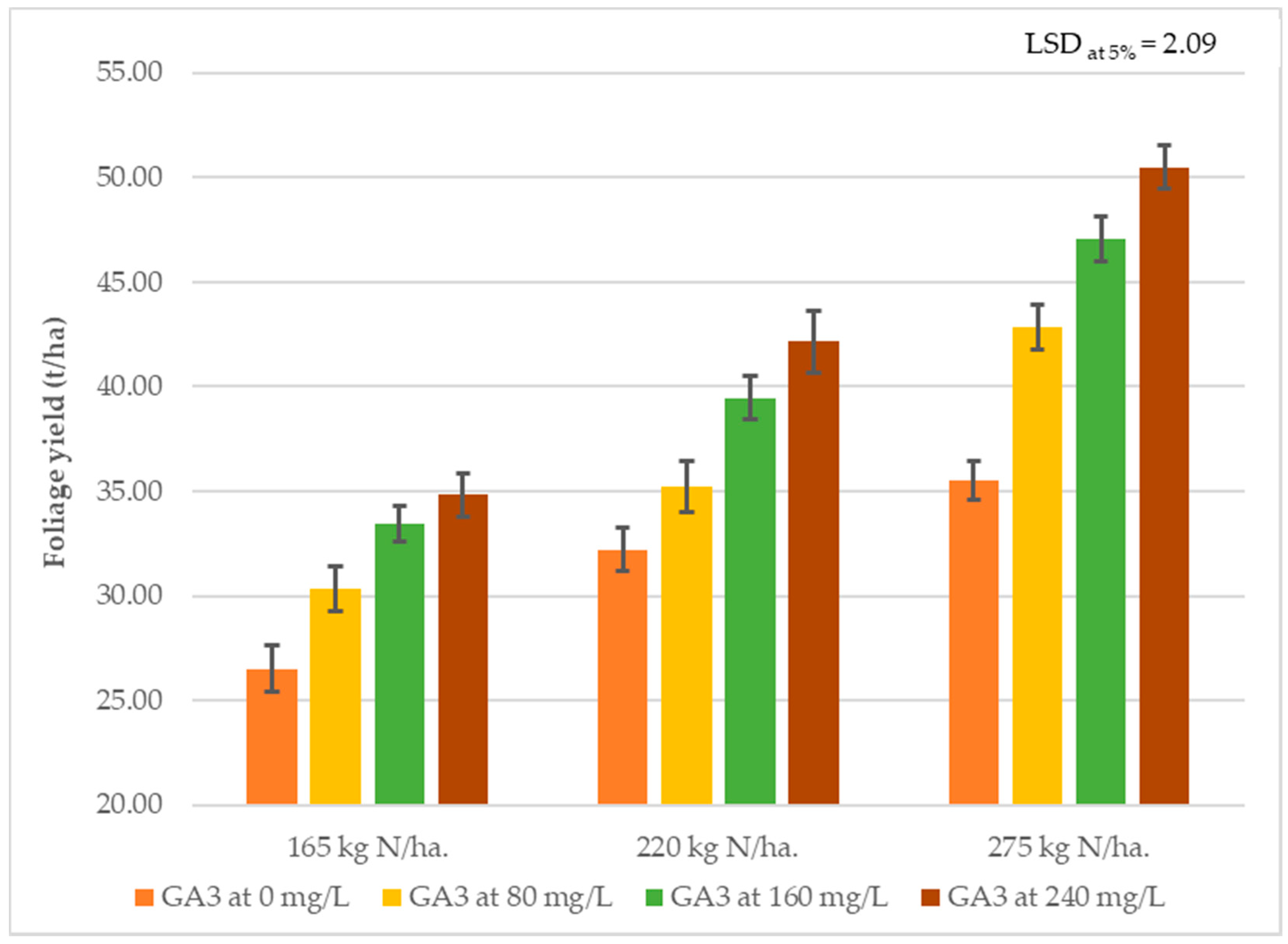

| Soil Analysis | 2014/2015 | 2015/2016 | |
|---|---|---|---|
| Mechanical analysis | Sand (%) | 21.55 | 21.90 |
| Silt (%) | 29.84 | 30.29 | |
| Clay | 48.60 | 47.80 | |
| Texture | Clay | Clay | |
| Chemical analysis | Soil reaction pH | 7.50 | 7.60 |
| ECe (dsm−1) | 1.37 | 1.33 | |
| Organic matter (%) | 1.15 | 1.20 | |
| Available N (ppm) | 45.80 | 46.50 | |
| Available P (ppm) | 1.40 | 1.55 | |
| Exchangeable (ppm) | 120.20 | 135.30 |
| Traits Treatments | Root Length (cm) | Root Diameter (cm) | Root Fresh Weight (g/plant) | Foliage Fresh Weight (g/plant) | Root Yield (t/ha) | |||||
|---|---|---|---|---|---|---|---|---|---|---|
| I | II | I | II | I | II | I | II | I | II | |
| A. Nitrogen fertilizer levels | ||||||||||
| 165 kg N/ha. | 28.8c | 29.0c | 9.8c | 9.5c | 732.8c | 720.0c | 381.6c | 357.5c | 60.4c | 59.4c |
| 220 kg N/ha. | 30.5b | 30.7b | 10.8b | 10.6b | 819.1b | 805.1b | 455.6b | 431.3b | 67.7b | 66.6b |
| 275 kg N/ha. | 32.9a | 32.8a | 11.5a | 11.2a | 919.8a | 876.8a | 535.9a | 492.5a | 75.9a | 72.6a |
| F. Test | * | * | * | * | * | * | * | * | * | * |
| B. GA3 spraying concentrations | ||||||||||
| GA3 at 0 mg/L | 29.7b | 30.0b | 10.2d | 9.9c | 784.6d | 767.2d | 384.2d | 356.3d | 64.4d | 63.0d |
| GA3 at 80 mg/L | 30.1b | 30.3b | 10.6c | 10.3b | 812.9c | 795.4c | 441.7c | 418.8c | 67.1c | 65.6c |
| GA3 at 160 mg/L | 31.4a | 31.3a | 10.9b | 10.6a | 840.0b | 810.8b | 487.1b | 445.4b | 69.6b | 67.2b |
| GA3 at 240 mg/L | 31.7a | 31.7a | 11.1a | 10.8a | 858.0a | 829.0a | 517.9a | 487.9a | 70.9a | 68.8a |
| F. Test | * | * | * | * | * | * | * | * | * | * |
| C. GA3 spraying times | ||||||||||
| 60 DAP | 30.8a | 31.0a | 10.8a | 10.6a | 834.8a | 803.9a | 472.1a | 435.5a | 68.7a | 66.8a |
| 120 DAP | 30.7a | 30.7a | 10.6b | 10.3b | 813.0b | 797.3b | 443.3b | 418.7b | 67.3b | 65.6b |
| F. Test | NS | NS | * | * | * | * | * | * | * | * |
| D. Interaction effects | ||||||||||
| A × B | NS | NS | NS | NS | * | NS | * | * | * | NS |
| A × C | NS | NS | NS | NS | NS | NS | NS | NS | NS | NS |
| B × C | NS | NS | NS | NS | NS | NS | NS | NS | NS | NS |
| A × B × C | NS | NS | NS | NS | NS | NS | NS | NS | NS | NS |
| Traits Treatments | Foliage Yield (t/ha) | Sucrose (%) | TSS (%) | Purity (%) | Sugar Yield (t/ha) | |||||
|---|---|---|---|---|---|---|---|---|---|---|
| I | II | I | II | I | II | I | II | I | II | |
| A. Nitrogen fertilizer levels | ||||||||||
| 165 kg N/ha. | 31.3c | 29.1c | 20.5a | 20.3a | 26.3a | 25.6a | 78.0a | 79.1a | 12.356b | 12.025c |
| 220 kg N/ha. | 37.3b | 35.5b | 18.8b | 19.0b | 24.9b | 24.3b | 75.4b | 78.3a | 12.703b | 12.650b |
| 275 kg N/ha. | 43.9a | 40.5a | 17.9c | 18.0c | 24.2c | 23.6c | 73.8c | 76.3b | 13.544a | 13.059a |
| F. Test | * | * | * | * | * | * | * | * | * | * |
| B. GA3 spraying concentrations | ||||||||||
| GA3 at 0 mg/L | 31.4d | 29.1d | 19.5a | 19.6a | 25.7a | 25.0a | 76.0a | 78.2a | 12.504b | 12.254b |
| GA3 at 80 mg/L | 36.1c | 34.5c | 19.3ab | 19.3ab | 25.4ab | 24.7ab | 75.9a | 77.9a | 12.892a | 12.604ab |
| GA3 at 160 mg/L | 39.9b | 36.6b | 19.1b | 19.1b | 25.2b | 24.5b | 75.5a | 77.8a | 13.171a | 12.792a |
| GA3 at 240 mg/L | 42.5a | 40.0a | 18.3c | 18.5c | 24.3c | 23.8c | 75.5a | 77.7a | 12.904a | 12.663a |
| F. Test | * | * | * | * | * | * | NS | NS | * | * |
| C. GA3 spraying times | ||||||||||
| 60 DAP | 38.7a | 35.7a | 19.4a | 19.5a | 25.4a | 24.8a | 76.3a | 78.4a | 13.208a | 12.935a |
| 120 DAP | 36.3b | 34.4b | 18.7b | 18.8b | 24.9b | 24.2b | 75.1a | 77.4a | 12.527b | 12.221b |
| F. Test | * | * | * | * | * | * | NS | NS | * | * |
| D. Interaction effects | ||||||||||
| A × B | * | * | NS | NS | NS | NS | NS | NS | NS | NS |
| A × C | NS | NS | NS | NS | NS | NS | NS | NS | NS | NS |
| B × C | NS | NS | NS | NS | NS | NS | NS | NS | NS | NS |
| A × B × C | NS | NS | NS | NS | NS | NS | NS | NS | NS | NS |
Publisher’s Note: MDPI stays neutral with regard to jurisdictional claims in published maps and institutional affiliations. |
© 2021 by the authors. Licensee MDPI, Basel, Switzerland. This article is an open access article distributed under the terms and conditions of the Creative Commons Attribution (CC BY) license (http://creativecommons.org/licenses/by/4.0/).
Share and Cite
Leilah, A.A.A.; Khan, N. Interactive Effects of Gibberellic Acid and Nitrogen Fertilization on the Growth, Yield, and Quality of Sugar Beet. Agronomy 2021, 11, 137. https://doi.org/10.3390/agronomy11010137
Leilah AAA, Khan N. Interactive Effects of Gibberellic Acid and Nitrogen Fertilization on the Growth, Yield, and Quality of Sugar Beet. Agronomy. 2021; 11(1):137. https://doi.org/10.3390/agronomy11010137
Chicago/Turabian StyleLeilah, Ahmed A. A., and Naeem Khan. 2021. "Interactive Effects of Gibberellic Acid and Nitrogen Fertilization on the Growth, Yield, and Quality of Sugar Beet" Agronomy 11, no. 1: 137. https://doi.org/10.3390/agronomy11010137
APA StyleLeilah, A. A. A., & Khan, N. (2021). Interactive Effects of Gibberellic Acid and Nitrogen Fertilization on the Growth, Yield, and Quality of Sugar Beet. Agronomy, 11(1), 137. https://doi.org/10.3390/agronomy11010137






